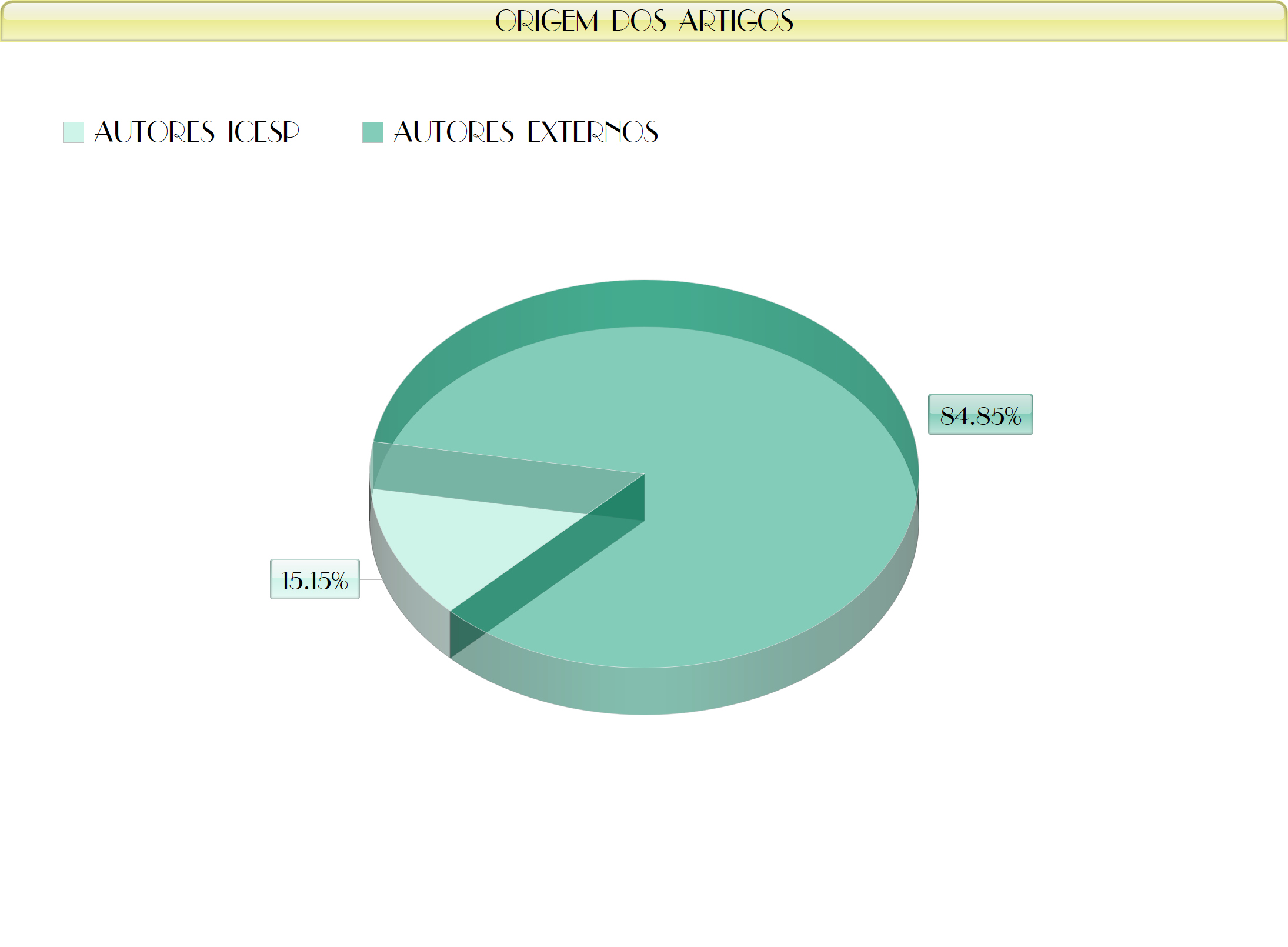IDENTIFICAÇÃO DE MICRORGANISMOS QUE CAUSAM CÂNCER
Resumo
Resumo
Objetivo: Após o sucesso na identificação de vírus associados ao aparecimento de tumores em animais no século XIX, com o trabalho pioneiro de Rous, os cientistas passaram a buscar por vírus oncogênicos humanos. A suscetibilidade ao câncer é determinada pela interação de múltiplos genes. Porém, a ocorrência da doença é fortemente determinada por fatores como dieta, tabagismo, agentes infecciosos e exposições ambientais e ocupacionais a agentes cancerígenos. Entre estes fatores de risco, os agentes infecciosos podem ser uma importante causa evitável de câncer. O presente projeto tem como objetivo identificar os microrganismos que causam câncer e o mecanismo de ação para que uma infecção desencadeie um câncer. Fontes de dados: Foram utilizadas bibliografias na forma de livros e artigos científicos. Os artigos científicos foram pesquisados através dos seguintes bancos de dados: NCBI, Scielo, Med Line e Portal CAPES entre Agosto de 2014 e Junho de 2015. Foram utilizadas as seguintes palavras-chave para seleção dos artigos: neoplasia, infecção, carcinogênese, agentes infecciosos e biologia do câncer. Síntese dos dados: Com base em evidências de estudos epidemiológicos e biológicos, os seguintes microrganismos são agentes cancerígenos: vírus Epstein-Barr (EBV), vírus do papiloma humano (HPV), o vírus da hepatite B (HBV), vírus da hepatite C (HCV), Vírus Humano T-linfotrópico tipo 1 (HTLV-1), bem como a bactéria Helicobacter pylori. Conclusão: Este estudo mostrou que existe relação entre o câncer e microrganismos, o que faz com que medidas de prevenção das infecções sejam cada vez mais importantes para o controle das mesmas e possivelmente processos que possam desencadear um câncer.
Palavras-chave: neoplasia; infecção; carcinogênese; agentes infecciosos; biologia do câncer.
Abstract
Objective: After successfully identify viruses associated with the development of tumors in animals in the nineteenth century with the pioneering work of Rous, scientists began to search for human oncogenic virus. The susceptibility to cancer is determined by the interaction of multiple genes, however, the occurrence of the disease is largely determined by factors such as diet, smoking, infectious agents and environmental and occupational exposures to carcinogens. Among these risk factors, infectious agents may be an important preventable cause of cancer. This project aims to identify organisms that cause cancer and the mechanism of action for an infection triggers cancer. Data sources: bibliographies were used in the form of books and scientific articles. The papers were searched using the following databases: NCBI, Scielo, Med Line and Portal CAPES between August 2014 and June 2015, using the following keywords to select articles: neoplasm, infection, carcinogenesis, infectious agents and cancer biology. Synthesis Data: Based on evidence from epidemiological and biological studies, the following microorganisms are carcinogens: Epstein-Barr (EBV) virus, human papilloma virus (HPV), hepatitis B virus (HBV), hepatitis C virus (HCV), Human T-lymphotropic virus type 1 (HTLV-1), and the bacterium Helicobacter pylori. Conclusion: This study showed that there is a relationship between cancer and the microorganism that causes the infection prevention measures are increasingly important for the control of the same and possibly processes that can trigger cancer.
Keywords: cancer; infection; carcinogenesis; infectious agents; cancer biology.
figshare DOI: 10.6084/m9.figshare.9788750
Palavras-chave
Texto completo:
PDFReferências
Azran I, Schavinsky-Khrapunsky Y, Aboud M. Role of tax protein in human t-cell leukemia virus type-i leukemogenicity. Retrovirology 2004, 1, 20.
Brasil. Ministério da Saúde. A situação do câncer no Brasil/ Ministério da Saúde, Secretaria de Atenção à Saúde, Instituto Nacional de Câncer, Coordenação de Prevenção e Vigilância. Rio de Janeiro: INCA, 2006.
Brasil. Ministério da Saúde. Instituto Nacional do câncer - INCA – Estimativa 2010 – Incidência de Câncer no Brasil. Rio de Janeiro: Ministério da Saúde; 2009.
Campoli M, Ferrone S, Zea AH, Rodriguez PC, Ochoa AC. Mechanisms of tumor evasion. Cancer Treat Res 123: 61-88, 2005.
Carrilo-Infante C, Abbadessa G, Bagella L, Giordano A. Viral infections as a cause of cancer (review). Int J Oncol. 2007 Jun; 30 (6): 1521-8.
Catalán P, Alb A. Profilaxis de enfermedad por vírus de Epstein Barr em niños y adultos receptores de transplante de órganos sólidos y de precursores hematopoyéticos. Revista Chilena Infectol 2012; (29) (Supl 1): 29-31.
de Villiers Em, Fauquet C, Broker TR, Bernanrd HU, Zur Hausen H. (2004) Virology 324, 17–27.
de Visser KE, Coussens LM. The interplay between innate and adaptive immunity regulates cancer development. Cancer Immunol Immunother. 54: 1143-1152, 2005.
Devita Jr, Vincent T, Hellman S, Rosenberg SA. Cancer: principles and practice of oncology. 7. ed. Philadelphia: Lippincott Williams & Wilkins, 2005. 3120 p.
Dolcetti R, Masucci MG. Epstein-Barr virus: induction and control of cell transformation.J Cell Physiol 2003; 196(2): 207-18.
Eslick D, Lim LLY, Byles JE, Xia HHX., Talley NJ. Association of Helicobacter pylori infection with gastric carcinoma: a meta-analysis. Am J Gastroenterol 1999;94:2373-9.
Fehervari Z, Sakaguchi S. CD4+. Tregs and immune control. J Clin Invest 114: 1209-1221, 2004.
Ferreira LL, Demathé A, Bernabé DG, Carli JP, Goiato MC, Miyahara GI. O papel do Epstein Barr vírus na carcinogênese oral. Odonto 2012; 20(39): 45-51.
Gan DD, Macaluso M, Cinti C, Khalili K, Giordano A. How does a normal human cell become a cancer cell. J Exp Clin Cancer Res 4: 509-516, 2003.
Gonçalves DU, Proietti FA, Ribas JGR, Araújo, M.G.; Pinheiro, S.R.; Guedes, A.C.; Carneiro-Proietti, A.B.F. Epidemiology, Treatment na prevention of Human T-Cell Leukemia Virus Type 1-Associated Diseases. Clinical Microbiology Reviews, July 2010, p. 577-589.
González X, Correnti M, Rivera H, Perrone M. Epstein Barr Virus detection and latent membrane protein 1 in oral hairy leukoplakia in HIV+ Venezuelan patients. Med Oral Patol Oral Cir Bucal 2010; 15(2): e297-302.
Guimarães J, Corvelo TC, Barile KA. Helicobacter pylory: Fatores relacionados à sua patogênese. Revista Paraense de Medicina V.22 (1) janeiro a março 2008.
Hsieh WS, Lemas MV, Ambinder RF. The biology of Epstein-Barr virus in post-transplant lymphoproliferative disease. Transpl Infect Dis. 1999;1(3):204-12.
IARC - International Agency for Research on Cancer. Section of Infections – Infections and Cancer Biology Group. France, 2015.http://www.iarc.fr/en/research-groups/ICB/index.php. Acesso em 19/07/2015.
Karakosta A, Golias C, Charalabopoulos A, Batistatou A, Charalabopoulos K. Genetic models of human cancer as a multistep process. Paradigm models of colorectal cancer, breast cancer: and chronic myelogenous and acute lymphoblastic leukaemia (review). J Exp Clin Cancer Res 24: 505-513, 2005.
Kew MC. Epidemiology of chronic hepatitis b virus infection, hepatocellular carcinoma, and hepatitis b virus-induced hepatocellular carcinoma. Pathol.-Biol. 2010, 58, 273–277.
Kodaira MS, Escobar AMU, Grisi S. Aspectos epidemiológicos do Helicobacter pylori na infância e adolescência. Revista Saúde Pública 2002; 36(3):356-69.
Lima MAP, Rabenhorst SHB. Associação do virus Epstein-Barr (EBV) com tumores sólidos. Revista Brasileira de Cancerologia 2006; 52(1): 87-96.
Manns A, Blanttner WA. The epidemiology of the human T-cell lymphotrophic virus type I and type II: etiologic role in human disease. Transfusion 31:67–75, 1991.
Marshall BJ. Helicobacter pylori. The American Journal of Gastroenteology. 1994, 89:S116-s128.
Mills KH. Regulatory T cells: friend or foe in immunity to infection? Nat Rev Immunol 4: 841-855, 2004.
Ministério da Saúde. Manual dos Centros de Referência de Imunobiológicos Especiais. Brasília: Fundação Nacional de Saúde; 2001. p. 59-63.
Morales-Sánchez A, Fuentes-Pananá EM. Human viruses and Cancer. Viruses 2014, 6, 4047-4049;doi:10.3390/v6104047.
Osame M, Janssen R, Kubota H, Nishitani H, Igata A, Nagataki S, Mori M, Goto I, Shimabukuto H, Khabbaz R. Nationwide survey of HTLV-I-associated myelopathy in Japan: association with blood transfusion. Ann. Neurol. 28:50–56, 1990.
Papaiordanou F, Ribeiro-Junior MAF, Saad WA. Prevenção do carcinoma hepatocelular. ACBD Arq Bras Cir Dig 2009;22(2):115-9.
Pár, A. Prophylaxis and treatment of chronic viral hepatitis as the prevention of hepatocellular carcinoma. Orv Hetil. 2009 Jan 4;150(1):19-26.
Parkin DM. The global health burden of infection-associated cancers in the year 2002 (review). Int J Cancer 118: 3030-3044, 2006.
Pharoah PD. Genetic susceptibility, predicting risk and preventing cancer. Recent Results in Cancer Research, v. 163, p.7-18, 2003.
Pinheiro MM, Queiroz LLC, Lima JMMP. HPV e o desenvolvimento de neoplasias: Uma revisão integrativa de literatura. Revista Ciência Saúde v15, n.1, p. 19-27 jan-jun, 2013.
Rous, P. Transmission of a malignant new growth by means of a cell-free filtrate. JAMA. 191; 56:198.
Schottenfield D, Beebe-Dimmer JL. Advances in cancer epidemiology: understanding causal mechanisms and the evidence for implementing interventions. Ann Rev Public Health 26:37-60, 2005.
Shao Y, Sun K, Xu, W, Li X, Shen H, Sun W. Helicobacter pylory infection, gastrin and cyclooxygenase-2 in gastric carcinogenesis. World J Gastroenterol 2014 September 28; 20(36): 12860-12873.
Sichero L, Rabachini T. Vírus e câncer. In: Lopes A, Chammas R, Iyeyasu H. Oncologia para a graduação. 3 ed. São Paulo: Lemar, 2013. p 62-65.
Simmonds P, Bukh J, Combet C, Deleag G, Enomoto N Feinstone S, Halfon P Inchauspe G, Kuiken C Maertens G. Consensus proposals for a unified system of nomenclature of hepatitis c virus genotypes. Hepatology 2005, 42, 962–973.
Stanley MA, Pett, MR, Coleman N. HPV; from infection to cancer. Biochemical Society Transactions (2007) Volume 35, part 6.
Stolte M, Meining A. Helicobacter pylori and gastric câncer. The Oncologist 1998; 3:124-128.
Tang H, Grise H. Cellular and molecular biology of hcv infection and hepatitis. Clin. Sci. 2009, 117, 49–65.
Ueno Y, Sollano JD, Farrell GC. Prevention of hepatocellular carcinoma com-plicating chronic hepatitis C. J Gastroenterol Hepatol. 2009 Apr;24(4):531-6
Apontamentos
- Não há apontamentos.
Revista Brasileira de Pesquisa em Ciências da Saúde - RBPeCS - ISSN: 2446-5577
Indexadores:













